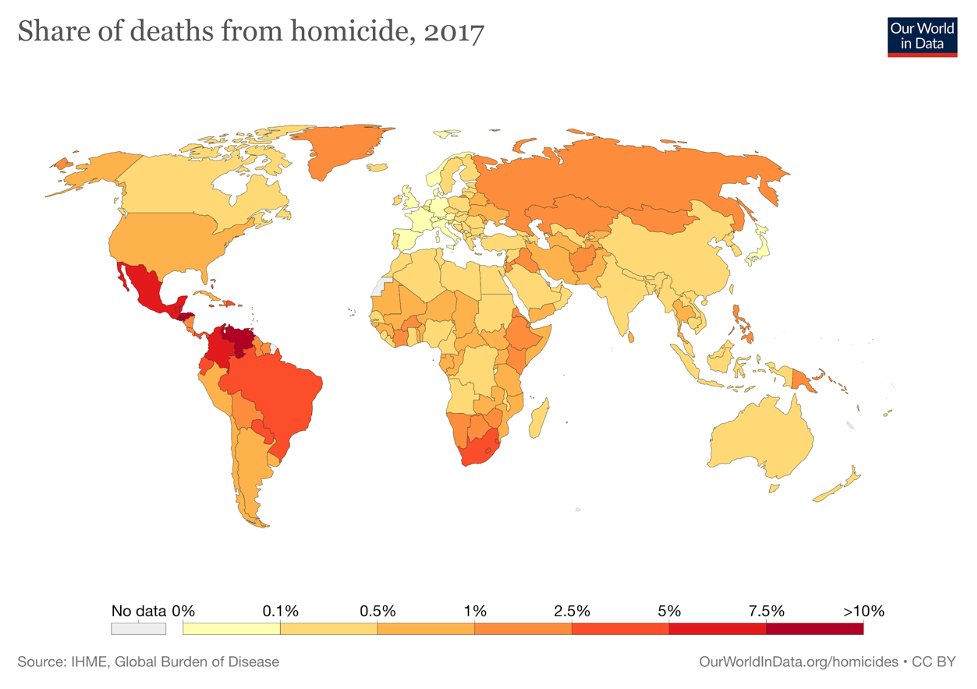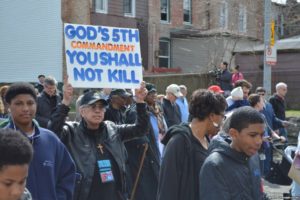
By Jalen Whitehead
Gun control has long been a controversial topic, especially in the United States.
Most Americans believe guns are essential to their freedom, a sentiment enshrined in the Second Amendment’s guarantee of the right to bear arms. Americans own almost 50 percent of the civilian-owned guns worldwide and has 120.5 guns per capita, which is more than any other country, according to the Small Arms Survey database.
Gun suicide and gun homicide are major issues in the United States. Nearly two-thirds of all gun deaths in the U.S. are suicides, according to the Centers for Disease Control and Prevention’s National Center for Injury Prevention and Control.
The homicide rate in America is 25.2 times higher than any other high-income country in the world, according to a CNN report. On average, 30 people will be shot and killed every day. Despite the fact that there have been over 100 mass shootings since 1982, Americans still have an attachment to guns that they cannot let go of.
Gun control advocates say limiting access is the answer. However, looking at other high-income countries and their approach to guns, does reduced access to guns actually reduce gun violence?
Dr. Garen Wintemute, a gun violence expert at UCLA, said in an interview, “There’s a huge amount of research showing that it does, at both the individual and population levels.”
He said he believes the root of gun violence in America is “structural violence,” which refers to systemic inequities in areas such as health care and income that cause harm to particular groups.
After a mass shooting in the United States, the conversation that always arises is whether new gun laws are needed to make the country safe. Proposals are made, but most do not become law.
Mass shootings do not make up a large part of gun-related deaths, but happen at an alarming rate. The death rate for mass shooting deaths is 0.089 per 1 million people. However, in 2015 alone there were 372 mass shootings, and 64 school shootings. According to the Washington Post, 305 mass shootings had occurred by July 19 of this year. There were 417 mass shootings by the end of 2019, according to the Gun Violence Archive, which defines a mass shooting as one where four or more people are shot.
States with less strict gun laws have more mass shootings than those with stricter gun laws, the Post article found. In 2019 lawmakers in the House introduced the Bipartisan Background Checks Act, which calls for tougher background checks for all gun purchasers and is the first major gun control legislation in decades, according to the New York Times, but the bill has not passed the Senate.
Wintemute said that other high-income countries have “either much lower prevalence of ownership or much more rigorous systems of regulation.”
Canada
In Canada, in 1989 a student went into a school with a semiautomatic rifle and killed 14 students and injured more than a dozen others. That event led the government to put major gun reforms in place, according to the PBS Newshour, including a 28-day waiting period to purchase guns, mandatory safety courses, in-depth background checks, bans on large magazines and bans and restrictions on military-style weapons.
Canada also broke down firearms into three classes: non-restricted guns, restricted guns and prohibited weapons. Prohibited weapons include automatic weapons. It is illegal to own a fully automatic weapon in Canada. In 1995 changes in the law were made that required a person to obtain a license to buy a gun and ammunition. In 2012, however, this law was changed and citizens no longer have to register non-restricted guns, the PBS article said.
In early 2020, Prime Minister Justin Trudeau banned 1,500 military-style weapons in the country. This happened two weeks after a gunman killed nearly two dozen people in Nova Scotia in April, Canada’s deadliest mass shooting since 1989. Canadians are no longer allowed to sell, buy, use or import those military-style weapons the prime minister banned, according to Politico. People who already own these types of guns will have a two-year period to surrender the weapons and will be given “compensation” for their compliance. The legislation will prohibit any person considered too dangerous to own guns from being able to buy one.
Canada’s homicide rate in 2018 was 1.78 per 100,000 people versus 5.3 per 100,000 people in the United States. In 1984, before the changes in the law after the 1989 mass shooting, according to Statistics Canada website, the homicide rate was nearly 3.0 per 100,000 people. In most recent years, Canada has seen a slight increase in gun homicides due to more guns being imported. Toronto is responsible for much of this increase, with 44 people shot dead in 2019, which is triple the number of people killed in 2014, according to NPR. Gun suicide accounts for more gun deaths in Canada than gun homicides. Canada still maintains a lower rate of gun violence than the United States.
Australia
In Australia, the same type of incident sparked a motion for major gun reforms. In 1996, the country witnessed a mass shooting that resulted in the death of 35 people and the wounding of dozens of others. About two weeks later, the country enacted changes to gun regulation. The country prohibited semiautomatic and automatic guns and made licensing and registration mandatory. Australia conducted a temporary buyback of over 650,000 assault guns from the public, which one study estimated was about one-fifth of the national stock of guns. This was only a buyback of assault weapons and not all guns, making for the relatively low rate. Over time more guns have been turned over to the government.
Another buyback program was started in 2003, this time for handguns. Both buyback programs saw decreases in the number of homicides and suicides. After the new firearm regulations in 1996, the gun death rate began to decrease at a rate of 6 percent per year, according to The Guardian. In the same year the gun suicide rate began to decrease, and after the 2003 handgun buyback program, the death rate was lower than 1 per 100,000 people in the country, The Guardian reported.
In Australia, people can get certain guns only if they have a ‘“genuine need,” such as hunting and farming, which is a sharp contrast from America’s standards of allowing guns for recreational use.
Wintemute, the gun violence expert, indicated that a huge factor in America’s policies on gun possession stand from patriotic traditions deeming the right to carry as a national treasure. Having an “armed population” could be considered an effective way to have proper self-defense, he said, but is also a reason why gun deaths are so common, with guns being so readily available. Also, the root of the issue is not just the possession of guns but structural violence involving crime, he said.
Japan
Japan is home to one of the lowest homicide rates in the world, having only three gun deaths in 2015 and a gun homicide rate of nearly zero per 100,000 that year, according to Gunpolicy.org. Most guns are illegal in the country, besides those that police officers carry. The gun ownership rate in Japan is 0.6 per 100 people, compared with 88.8 per 100 people in America, according to the Japan Times. The only guns allowed are shotguns, guns for research purposes and guns for competition.
This change in gun ownership in the country is credited to World War II. After the war, Japan was dominated by a pacifist movement. In 1958 it was written into law that no person in the country could possess a firearm or a sword. The country has since relaxed the law, but still makes the process of getting a gun strict. Japanese citizens have to attend an all-day gun class and pass a shooting range test, according to Business Insider. Then they must pass a mental health test and pass a series of background tests, as well as other requirements. This makes it hard to obtain a gun in the country; people can only get shotguns and air rifles.
The overall crime rate in Japan is one of the lowest in the world.
Truth be told, reducing or restricting gun ownership appears to correlate to lower rates of gun violence in Canada, Australia and Japan. But what about the U.S., which is home to almost half the civilian-owned guns in the world?
When asked if America could ever reduce the number of guns in the country, Wintemute responded, “The point is that nothing of the sort will happen soon. We need to focus on efforts that will work even when lots of guns are in circulation.”
Wintemute suggested that there are a lot of effective ways to reduce gun violence besides simply taking them away. Some of his ideas include “preventing high risk individuals from purchasing them—those with a prior history of violent crime or active alcohol abuse, for example. [Also] community interventions focused on high-risk individuals or on preventing retaliation” shootings.
He also returned to one statistic, saying, “Don’t forget suicide, which accounts for nearly two-thirds of firearm deaths.”
Wintemute said a positive change on gun violence in America can happen eventually, but that “things are going to get worse first” until society ends its glorification of weapons.
